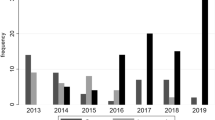Abstract
The objective of this is to compare the surgical outcomes of partial nephrectomy (PN), performed via three different approaches: robot-assisted (RAPN), laparoscopic (LPN), and open (OPN), in a single non-academic regional center. The data of patients undergoing PN at our Department from 2005 to 2016 were prospectively collected. A logistic regression model adjusted for preoperative variables (age, tumor size, creatinine and hemoglobin, ASA and Padua scores) was performed to evaluate whether transfusion, conversion, and postoperative complication rate were influenced by the surgical approach. Overall 270 patients underwent PN: analysis included 253 cases (RAPN = 110, LPN = 70, OPN = 73). Preoperative variables did not differ significantly among the three groups. Shorter operative (130 vs 180 and 200′) and ischaemia (12 vs 23 and 22′) times and longer hospital stay (8 vs 7 and 6 days) were found in the OPN group as compared to LPN and RAPN, respectively. The RAPN group included a higher rate of pT1b (31.8 vs 14.2 and 15%) and malignant histotype (90 vs 82.9 and 68.5%) as compared to LPN and OPN, respectively. Clavien Grade III–IV complications were lower in the RAPN (7.2%) as compared to OPN (12.3%) and LPN (17.1%) groups. Multivariate analysis showed a lower risk for conversion, transfusion and overall complications in the RAPN group versus LPN and OPN. The surgical approach affects the perioperative outcomes in a regional setting. The advantages of RAPN over OPN (lower risk of conversion, transfusion, and overall complications) are extended over LPN as well, although OPN offered faster operative and ischemia times at the expense of greater blood loss and hospital stay.
Similar content being viewed by others
References
Ljungberg B, Bensalah K, Canfield S et al (2015) EAU guidelines on renal cell carcinoma: 2014 update. Eur Urol 67:913–924
Campbell SC, Novick AC, Belldegrun A et al (2009) Guideline for management of the clinical stage 1 renal mass. J Urol 182:1271–1279
Dulabon LM, Lowrance WT, Russo P et al (2010) Trends in renal tumor surgery delivery within the United States. Cancer 116:2316–2321
Kim SP, Shah ND, Weight CJ et al (2011) Contemporary trends in nephrectomy for renal cell carcinoma in the United States: results from a population based cohort. J Urol 186:1779–1785
Patel HD, Mullins JK, Pierorazio PM et al (2013) Trends in renal surgery: robotic technology is associated with increased use of partial nephrectomy. J Urol 189:1229–1235
Sivarajan G, Taksler GB, Walter D, Gross CP, Sosa RE, Makarov DV (2015) The effect of the diffusion of the surgical robot on the hospital-level utilization of partial nephrectomy. Med Care 53:71–78
Ficarra V, Minervini A, Antonelli A et al (2014) A multicentre matched-pair analysis comparing robot-assisted versus open partial nephrectomy. BJU Int 113:936–941
Lee S, Oh J, Hong SK, Lee SE, Byun SS (2011) Open versus robot-assisted partial nephrectomy: effect on clinical outcome. J Endourol 25:1181–1185
Benway BM, Bhayani SB, Rogers CG et al (2009) Robot assisted partial nephrectomy versus laparoscopic partial nephrectomy for renal tumors: a multi-institutional analysis of perioperative outcomes. J Urol 182:866–872
Faria EF, Caputo PA, Wood CG, Karam JA, Nogueras-González GM, Matin SF (2014) Robotic partial nephrectomy shortens warm ischemia time, reducing suturing time kinetics even for an experienced laparoscopic surgeon: a comparative analysis. World J Urol 32:265–271
Mullins JK, Feng T, Pierorazio PM, Patel HD, Hyams ES, Allaf ME (2012) A comparative analysis of minimally-invasive partial nephrectomy techniques in the treatment of localized renal tumors. Urology 80:316–322
Lucas SM, Mellon MJ, Erntsberger L, Sundaram CP (2012) A comparison of robotic, laparoscopic and open partial nephrectomy. JSLS 16:581–587
Porpiglia F, Mari A, Bertolo R et al (2016) Partial nephrectomy in clinical T1b renal tumors: multicenter comparative study of open, laparoscopic and robot-assisted approach (the RECORd Project). Urology 89:45–53
Ficarra V, Novara G, Secco S et al (2009) Preoperative aspects and dimensions used for an anatomical (PADUA) classification of renal tumours in patients who are candidates for nephron-sparing surgery. Eur Urol 56:786–793
Dindo D, Demartines N, Clavien PA (2004) Classification of surgical complications: a new proposal with evaluation in a cohort of 6336 and result of a survey. Ann Surg 240:205–213
Luciani LG, Chiodini S, Donner D et al (2016) Early impact of robot-assisted partial nephrectomy on renal function as assessed by renal scintigraphy. J Robot Surg. 10:123–128
Benway BM, Wang AJ, Cabello JM, Bhayani SB (2009) Robotic partial nephrectomy with sliding-clip renorrhaphy: technique and outcomes. Eur Urol 55:592–599
Sprenkle PC, Power N, Ghoneim T et al (2012) Comparison of open and minimally invasive partial nephrectomy for renal tumors 4–7 centimeters. Eur Urol 61:593–599
Wang AJ, Bhayani SB (2009) Robotic partial nephrectomy versus laparoscopic partial nephrectomy for renal cell carcinoma: single-surgeon analysis of >100 consecutive procedures. Urology 73:306–310
Pierorazio PM, Patel HD, Feng T, Yohannan J, Hyams ES, Allaf ME (2011) Robotic-assisted versus traditional laparoscopic partial nephrectomy: comparison of outcomes and evaluation of learning curve. Urology 78:813–819
Author information
Authors and Affiliations
Corresponding authors
Ethics declarations
Conflict of interest
Lorenzo G. Luciani, Stefano Chiodini, Daniele Mattevi, Tommaso Cai, Marco Puglisi, William Mantovani, Gianni Malossini declare that they have no conflicts of interest.
Rights and permissions
About this article
Cite this article
Luciani, L.G., Chiodini, S., Mattevi, D. et al. Robotic-assisted partial nephrectomy provides better operative outcomes as compared to the laparoscopic and open approaches: results from a prospective cohort study. J Robotic Surg 11, 333–339 (2017). https://doi.org/10.1007/s11701-016-0660-2
Received:
Accepted:
Published:
Issue Date:
DOI: https://doi.org/10.1007/s11701-016-0660-2




